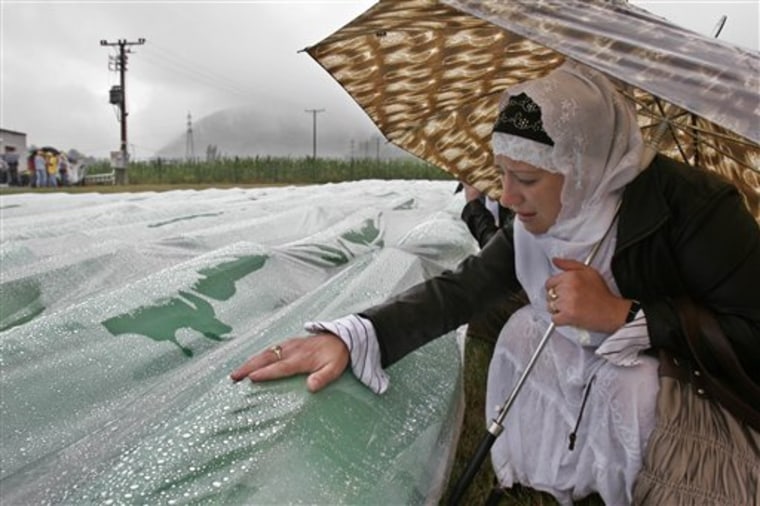Hundreds of newly identified victims of the 1995 Srebrenica massacre were reburied Wednesday, their relatives sobbing as the thin green coffins were laid in the ground on the 12th anniversary of the mass wartime killing.
More than 30,000 people turned out for the ceremony where a child read aloud the names of the 465 victims identified after being found in the many mass graves around Srebrenica. Before the ceremony, sobbing women moved among the coffins, searching for their loved ones' names and hugging each other for comfort.
Up to 8,000 Bosnian Muslims were killed by Serb forces who separated men and boys from women on July 11, 1995, and killed the males over several days. It was the worst mass slaughter in Europe since World War II.
Every year, more victims' bodies are found in dozens of mass graves around Srebrenica. DNA tests and other forensic methods have led to the identification and burial of more than 3,000 victims, including Wednesday's 465.
The bodies were laid to rest at a memorial center in the Srebrenica suburb of Potocari, which consists of a huge cemetery, a small museum and a row of marble blocks on which the names of the victims — those found and those not — are engraved.
Beyond the sea of 3,000 victims' graves lies a huge field awaiting the estimated 5,000 yet to be excavated from mass graves that have still not been found.
"Every year, we bury a few hundred. This will go on for another decade until we find and if we find and bury them all," says Mehmed Kolenovic, 54, who survived the ordeal.
Given no protection
During the 1992-95 war, the United Nations declared Srebrenica — which had been besieged by Serb forces throughout the war — a U.N.-protected safe area for civilians but then did nothing to prevent the massacre and expulsion.
In July 1995, Serb troops led by now indicted war crimes suspect Gen. Ratko Mladic overran the enclave. The outnumbered U.N. troops never fired a shot and could only watch as Mladic's troops rounded up the entire Srebrenica population in the Dutch compound and took the men away for execution.
"Only when you come here and see this field of graves, and meet the families, you start to understand the scale of the crime — genocide — that took place here 12 years ago," said Bosnia's recently appointed top international official, Miroslav Lajcak.
Some 15,000 men tried to escape the slaughter by fleeing over the mountains toward the safe town of Tuzla. They were hunted along their 65-mile walk and killed if caught. Hazim Mehmedovic was 3 years old at the time, and was carried along the path in his father's arms.
Hazim, now 16, arrived a few days ago from Copenhagen, Denmark, where he is living with his mother. Survivors today live in 107 countries around the world as refugees, he said.
Dark mark in U.N. history
For the past few days, he walked the escape route the other way from Tuzla to Srebrenica and arrived for the anniversary.
"I don't remember anything and wanted to see where it happened. The Serbs shelled our group and killed dad while he was holding me in his arms. Someone else, I don't know who, carried me the rest of the way to Tuzla," he says.
The body of Hazim's father, Edhem, was found in a mass grave along the route and buried last year in Potocari.
Srebrenica was described by former Secretary-General Kofi Annan as the darkest page of U.N. history.
Mladic and the former Serb leader, Radovan Karadzic, both indicted for genocide, are still in hiding. Mladic is believed to be in Serbia, while Karadzic's whereabouts are unknown.
A divided nation
Carla del Ponte, the chief prosecutor at the U.N. war crimes tribunal for the former Yugoslavia, attended Wednesday's ceremony. She has been pressing for the arrest of Karadzic and Mladic for years.
Muslim Bosnians have cited the massacre in their arguments for ending the country's postwar territorial division. The peace accord that ended the war divided the once multiethnic country into two ministates — one for Orthodox Christian Serbs and the other shared by Muslim Bosnians and Catholic Croats.
Srebrenica ended up in Serb-controlled territory of the ministate called Republika Srpska, or the Serb Republic. Muslim Bosnians consider the existence of Republika Srpska an award for the perpetrators, achieved through genocide.
"These innocent victims fell because of a project not worthy of humankind," said Haris Silajdzic, the Muslim member of Bosnia's three-person, multiethnic presidency. He called for the division to be dismantled and "for Bosnia not to be the way the perpetrators of this crime wanted it to be."
His Croat colleague in the presidency attended the ceremony, but his Serb colleague did not.
